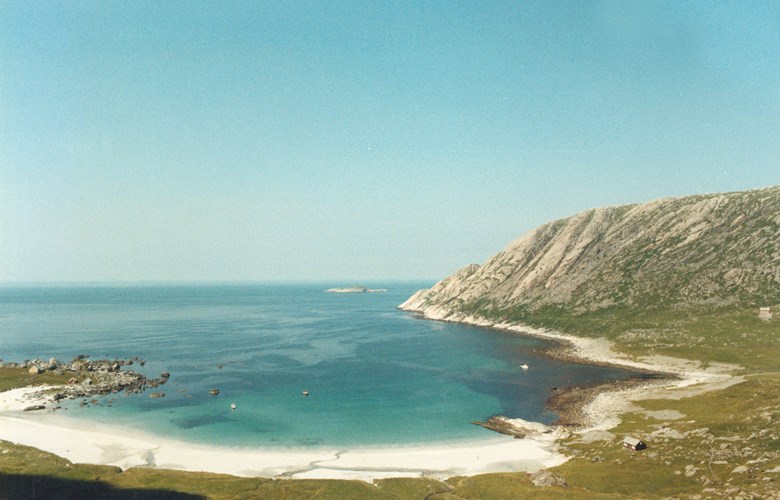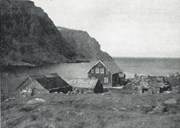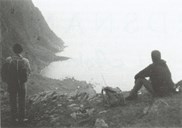Description from 1968
The vicar Arne Eltervaag paid a visit to the bay of Vetvika in 1968. Afterwards he described the trip in the church magazine:
".. like a gate in the middle of the black mountain. We now enter a quiet bay with a long, shiny white beach, encircled by a beautiful small hamlet: Vetvik. [..] We approach the buildings, empty and naked windowpanes stare curiously at us - but no persons can be seen. A door creaks on rusted hinges, a loose shutter is flapping in the wind, and the whole place is deserted and empty. An old barn has collapsed - it was not solid enough to withstand the forces of the elements on its own. Now there are broken bits of boards, window frames and tiles piled up inside the foundation walls."
Several farms
In the late 19th century, there were three fairly big farms around the bay of Vetvika. Up to 40 people lived there, and, with their own school and graveyard, the place formed a small rural community. However, where formerly cows grazed in the fields and many children played around the houses, it is now quiet. The remaining houses are now used only as holiday homes.
A victim of progress
"Vetvik fell victim to technology and progress. We are all so much poorer for it." This sad quote is taken from Reidar Torvanger, later to become mayor of Bremanger. He wrote an "obituary" over the place, when the last residents left in the autumn of 1951. Modern times had passed by the farms of Vetvika and when people left, this was a realization that it was not possible "to expect anything in the way of boat connection, road, electricity, or other social benefits we take for granted in a modern community."
Long history of settlement
When people left Vetvik for good, this meant the end of a long settlement tradition. Based on cultural remnants and legends, we can see a settlement dating back to prehistoric times, and there is an abundance of historic sources about Vetvika and its people.
If we go back to 1900, the situation seemed much brighter than what was the case in 1951. All in all, 36 people in six households then lived on the farms of Solheim and Vetvik. The population had risen steadily since the mid 19th century. The farms were also relatively big. As a matter of fact, the Solheim farm had the highest property tax at Bremangerlandet. The farms had extensive and good pastures, and the potato crops and the grain harvest could occasionally be fairly good. On the other hand, it also happened that the potato grass was "burned" because of the brine spray from the ocean.
Fishing and shipwreck
It was not only the good pastures that formed the basis for the settlement at Vetvik, but also the strategic location in terms of fisheries. It was a short distance to row out to the fishing grounds, and the farms had a rich salmon fishery. Still, history tells us that it was not always a blessing to live at such a place as there were many tragic shipwrecks in the area.
The worst disaster we know about happened in 1810, not in connection with fishing, but rather a wedding party. Anders Endreson from Vetvika was to be married to Marta Monsdotter from Førde, and had been to Grotle to pick up family members to the party. In spite of bad weather, they set out with perhaps as many as 11 wedding guests in the boat. Anders and his guests never made it. They all drowned and the planned party was replaced by grief and a wake. Anders, who had lost his own father at sea as an 11-year-old boy, now left behind a pregnant fiancée.
County allocations for better harbour facilities at Vetvika
The unpredictable weather made the county allocate means in the 1890s to build an emergency harbour with a jetty at Vetvika. The jetty with a landing facility for boats was completed in 1901, and it was not only meant to serve local people but also others who came to take part in the cod fishery northwest of Olderveggen. In the county recommendation it was also underlined that in the last few years, many fishermen had come to this area and that "being surprised by a southerly gale on the ocean was far more dangerous for them than for local people who were more familiar with these waters". It was soon proved that there was a need for such an emergency harbour. In 1907, 72 fishermen had to seek shelter at Vetvika at the same time. Like so many people before them, they had been surprised by a raging storm.
The weather was also an important reason why Vetvika in 1923 got its own graveyard. The journey to the final resting place could be quite cumbersome. It was hard enough for adults to transport the elderly and children across the mountains or row them to the church at Grotle and later to Frøyen. It goes without saying that it was not an ideal situation to stay weather-bound with the deceased. After getting their own graveyard, the people of Solheim and Vetvik could take care of the burial themselves, whereas the vicar could officiate at the funeral service when it was convenient for him.
Depopulation and war
In spite of the emergency harbour, graveyard, and later on a telephone line, the farms fell behind the development experienced elsewhere in the country. The number of residents gradually went down. An important reason for this was that the place was left in a backwater as far as communication was concerned. As long as the boats were small enough to be hauled up on land, people could still keep on fishing, but when bigger - and later on motorized - boats were taken into use, it became more difficult to use the harbour at Vetvika. Nor was the place included in the regular steamer service in the 20th century.
Admittedly, Vetvika had had much boat traffic for a while, but of a kind that is not found in any timetables. During the war there was much traffic from Vetvika across to Shetland. Not only with people from Bremanger but from other places in the country as well. This traffic went well for a while without any problems, but it abruptly came to an end in the autumn of 1942 when Gestapo arrested two men and sent them to imprisonment in Germany.
Phasing out
In 1951, then, the last persons left Vetvika for good. The general development in the society caused the local fisheries and the operation of the farms to become a backwater. Whereas the place earlier was well suited for a combination of fishing and farming, it was no longer suitable for either. Vetvika did not have harbour facilities adapted to modern fishing, and the other pillar in the settlement - farming - became more and more difficult. Self-sufficiency was for a long time a basic feature of farming, but in the first half of the 20th century, this farming method became less important and could not compete with a more market-oriented production. In the first few years after the Second World War, many small or isolated farms were shut down, whereas many of the remaining farms stopped labour-intensive farming systems, such as the operation of mountain farms.
Vetvika today
In spite of the depopulation, we cannot really talk about Vetvik and Solheim as deserted farms. Some of the buildings are still maintained. Some people are also tempted by the white beaches or the steep mountains to visit the place, either by boat or by hiking across the mountains.
The Vetvik song by Jørgina Vetvik
"På Vest-Noregs ville og sundskorne strand ei vik skjer seg inn, ligg open mot storhav med sjøbrått og brann i vêr og i vind. Ei fjellrekke ringar seg rundt og til side frå nord og til sør, og med utsyn så vide. I Nonsfjellet, aksla og Nebba så bratt, der dvergmålet ljomar ved dag og ved natt. Den vika er Vetvik på Bremangerland, ein avfolka stad. Men vi som voks opp der ved storstein og sand, vi kjenner oss glad når atter frå utferd vi heime kan finnast og framfarne dagar i samvær får minnast."






